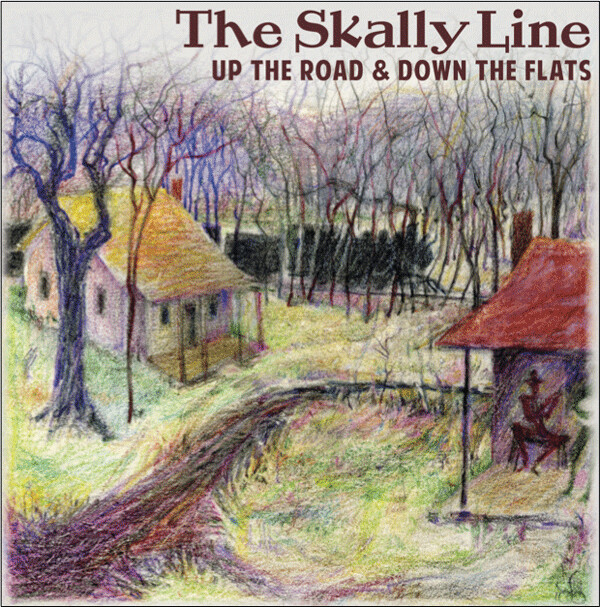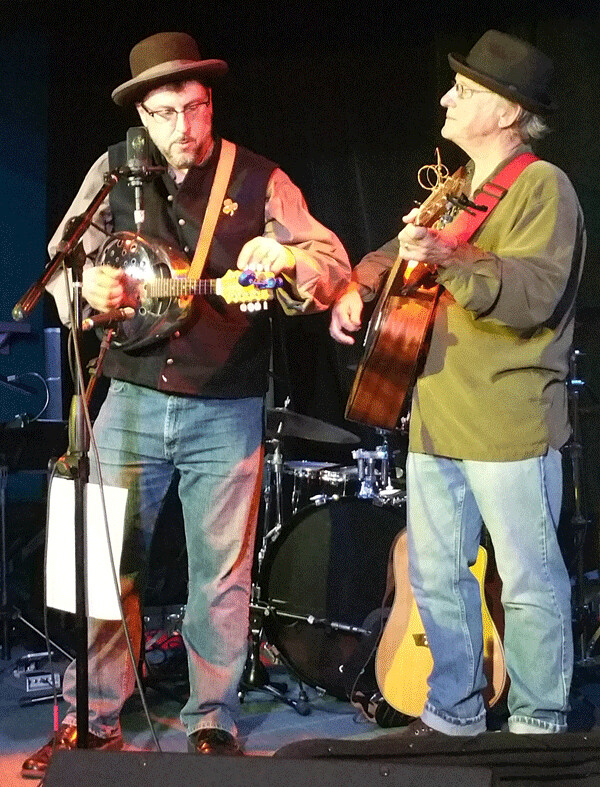The Skally Line: Up the Road and Down the Flats

“The past is a very big place to roam,” sings Fred Keller, a Sandstone-based musician who also happens to be a history buff. Along with guitarist Tom Cornish, The Skally Line is a two-man band that still manages to have a full, rich sound. It’s named after the railroad that ran from St. Paul starting in the 1870, turning Duluth from an outpost into a city but falling out of use over 100 years. “Skally” is a variation on the word skal well known to Vikings fans, used by the Swedish workers who built the line.
Keller is a familiar figure to the region’s folk scene, previously known for the Whistlepigs String Band which was active 2001-2009. Cornish plays folk guitar and fiddle (though he also plays electric guitar in a cover band) while Keller brings a cache of mandolins. Most curious of these is the “commodium,” made from a stainless steel bedpan and a pot lid, giving the instrument a strong resonance. It was made by Keith Carey, a California luthier who has collaborated with underground cartoonists Robert Crumb and Robert Armstrong in their musical ventures.
The album feels like the soundtrack of a historical movie waiting to be made. The lyrics can get pretty dark: “There’s a million ways to die / crushed by a skid or sliced by a raker or a peavey in the eye.” They perform this in educational shows for kids, who, of course, love it. If you know what a skid, raker or peavey are, you have a head start in appreciating this album. Each song has a story behind it, many of which Keller found at the Pine County Historical Society, all inviting a look into history.
“Three Little Drops” is the (mostly true) story of the Doyle Brothers and Blackjack Dawson, who ran an illegal speakeasy by the railroad tracks in Bruno, in between Duluth and Hinckley. They spiked the loggers’ drinks with drugs and robbed them, but weren’t too careful with the dosage, resulting in uncounted deaths.
The song’s narrator, Hiram Walsh, an actual pioneer, tells of meeting them in 1888, when he’d just arrived by train: “They met me at the door with a Colt .44 and a grin like the gates of Hell / Said run off to the woods, boy, you ain’t no good and we ain’t got nothing to sell.”
The next lines are fictional: “Late that night I heard a voice in the dark, says, boys, this one’s all done in / I’ll rack him and stack him, he ain’t a coming back and he won’t thaw out til spring.” It’s speculation on why they wouldn’t let Walsh inside: they had a victim on the floor.
“Looking for Grace” is about Charles R. Grace, who ran a hotel in the no-longer existing town of Kingsdale. The town was a hub for bootleggers and Grace complained to local deputies. So the song’s narrator, then a young moonshiner, carried out an order to light a pail of dynamite on porch. The blast blew out the windows and terrified the family, though no one was hurt. But 30 years later, the ex-moonshiner tracked down Grace in Moose Lake to apologize. The song is based on a 1955 article about the atonement.
“Government Road” is about the log road from Hastings, Minn. to Superior, Wis. which took 10 years to build, was terrible to travel on, and was used for only 10 years until the Skally Line made it obsolete.
“Washed Up on the Flats” is about a settler mourning the speed with which Minnesota turned from wilderness into settlement, based on a prayer to St. Anthony, patron saint of lost and stolen articles who seems to be popular in Minnesota. (St. Anthony Village and St. Anthony Falls in Minneapolis, St. Anthony Center in Duluth.)
“Don’t Make No Fuss Over My Remains” was inspired by a 1901 obituary of a wealthy, popular black woman. The song replicates the exuberant tone of the original obit but dials back on the racial dialect (“No Fuss Ovah My ‘Mains”) which newspapers commonly used at the time.
There are two instrumental pieces, “Goodby Blue Munde” (a reference to banjo player Alan Munde) and “Shanty Boys Polka." (Shanty Boys were lumberjacks and shanties their dwelling.) There are also a couple of non-historical songs, “Creep Along Charlie,” a musing on the pesky garden weed, and “My Home Out on the Prairie,” written by Cornish, a city-guy meets country-girl romance.

More details about the stories behind the songs can be found on Keller’s website, deepnorthmn.com. John Ramos has also written about finding remnants of the line in these pages. (June 15, 2017 and Nov. 30, 2017 Reader.)
